As the role expected of in-vehicle cameras grows, the challenges of development become more serious. For those involved in the design of in-vehicle cameras,
-High-speed transmission of high-definition data
-I want to reduce the heat effect and achieve miniaturization.
-Want to clear noise requirements for automotive
And you're probably looking for a better solution every day.
In this article, we will introduce the types of excellent solutions from Analog Devices, Inc., and their features that will help solve problems for those who are having trouble developing in-vehicle cameras.

In-Vehicle Camera Trends -Increase and Higher Image Quality-
With the spread of ADAS (Advanced Driver Assistance Systems) and autonomous driving systems, the following two trends can be seen in in-vehicle cameras.
(1) Increase in types and numbers
Rear view cameras, surround view systems, drive recorders, electronic mirrors, etc. have become commonplace, and the types and numbers of cameras are increasing.
The number of in-vehicle cameras per vehicle is expected to increase to 6 at autonomous driving level 2 + (plus) and 12 at autonomous driving level 3.
(2) High image quality
In order to ensure higher safety, higher image quality is required. ADAS already requires a resolution of 2MP pixels, but it is expected to reach 6MP or more in the future. Analog cameras, which have been widely used in the past due to their cost, are now lacking in resolution.
In the development of in-vehicle cameras, engineers are required to solve conflicting issues such as high image quality, miniaturization, measures against heat generation, and noise reduction.
Analog Devices Solutions for Cameras
A recommended solution to solve these challenges is provided by Analog Devices. Let's introduce what kind of lineup we have.
What kind of ICs are used in in-vehicle cameras? The figure below is a block diagram showing the components of an in-vehicle camera.
The image read by the camera module's CMOS sensor is transmitted to the camera control unit (ECU) via the GMSL interface.
Power is supplied from the ECU to the camera module by Power Over Coax, which superimposes power on the communication cable.
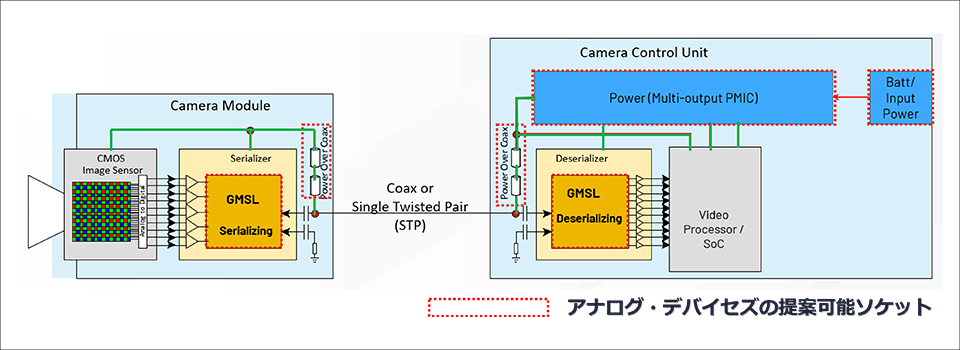
Blocks enclosed in a red frame can be proposed from the Analog Devices solution lineup.
<Solutions that Analog Devices can provide for in-vehicle cameras>
・GMSL (serializer, deserializer)
・Power supply (primary, secondary)
・Power Over Coax (transmitting side, receiving side)
Let's take a look at each function and feature.
Camera interface GMSL compatible with ADAS
One of the challenges in improving the image quality of in-vehicle cameras is the transmission of images captured by high-resolution digital cameras between devices.
Analog Devices offers GMSL (Gigabit Multimedia Serial Link) SerDes ICs that enable serial transmission of large amounts of data.
Combining a serializer (transmitting side) and a deserializer (receiving side), high-quality video data can be transmitted over a wide bandwidth.
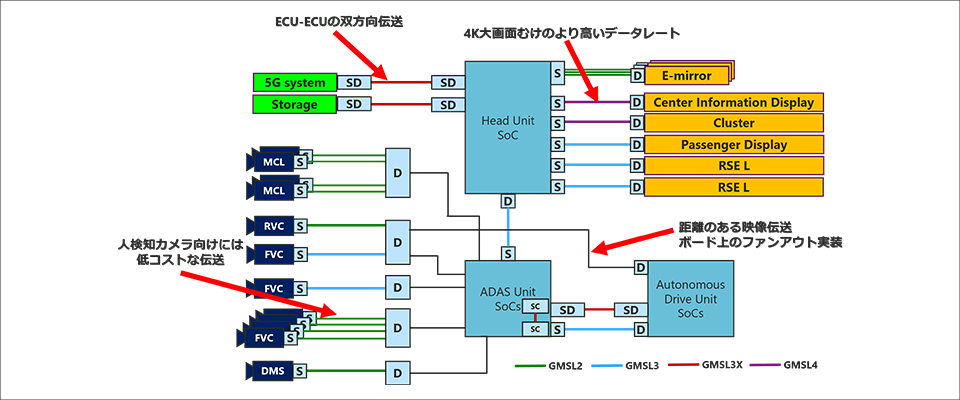
Both GMSL serializers and deserializers support a wide variety of interfaces.
Since various systems can be flexibly connected, complex mutual communication can be realized with simple circuits.
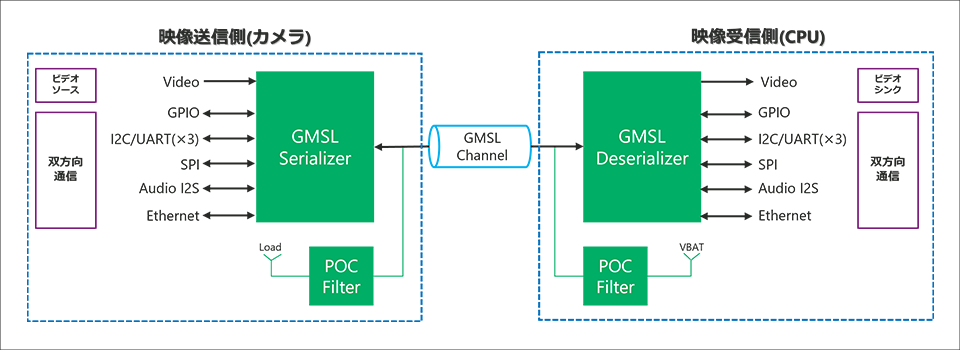
A wide range of products are available. Depending on the required transmission volume, the solutions we can propose will change.
GMSL Solution Lineup
■ Serializer product selection guide
| model number | input | interface | Speed (Mbps) | HDCP | application |
| MAX96707 | 14 | CMOS/LVDS | 1740 | 1.74Gbps small camera | |
| MAX96709 | 14 | CMOS/LVDS | 1740 | ||
| MAX96705 | 16 | CMOS/LVDS | 1740 | ||
| MAX96711 | 14 | CMOS/LVDS | 1740 | ||
| MAX9271 | 16 | CMOS/LVDS | 1500 | 1.5Gbps camera/display | |
| MAX9273 | 22 | CMOS/LVDS | 1500 | ||
| MAX9249 | 4 | LVDS | 2500 | 2.5Gbps camera/display | |
| MAX9259 | 30 | CML | 2500 | ||
| MAX9293 | - | HDMI | 3120 | 〇 | 3.12Gbps display |
| MAX9277 | 4 | LVDS | 2800 | ||
| MAX9281 | 4 | LVDS | 2800 | 〇 | |
| MAX9275 | 30 | LVCMOS | 2800 | ||
| MAX9279 | 30 | LVCMOS | 2800 | ||
| MAX9291 | - | HDMI | 3120 |
Only part of the lineup is shown. Other applicable products are also available.
■ Deserializer Product Selection Guide
| model number | input | interface | Speed (Mbps) | HDCP | application |
| MAX96796 | 14 | CMOS/LVCMOS | 1740 | 1.74Gbps small camera | |
| MAX96708 | 14 | CMOS/LVCMOS | 1740 | ||
| MAX9272A | 28 | CMOS/LVCMOS | 1500 | 1.5Gbps camera/display | |
| MAX9264 | 30 | CMOS/LVCMOS | 2500 | 〇 | 2.5Gbps camera/display |
| MAX9268 | 4 | LVDS | 2500 | ||
| MAX9260 | 30 | CMOS/LVCMOS | 2500 | ||
| MAX9278A | 4 | LVDS | 3210 | 3.12Gbps display | |
| MAX9282A | 4 | LVDS | 3210 | 〇 | |
| MAX9276A | 32 | CMOS/LVCMOS | 3210 | ||
| MAX9280A | 32 | CMOS/LVCMOS | 3210 | 〇 | |
| MAX9288 | 4 | CSI-2 | 3210 | ||
| MAX9278 | 4 | LVDS | 3210 | ||
| MAX9286 | 4 | CSI-2 | 1500 | Quad SER input for camera |
Only part of the lineup is shown. Other applicable products are also available.
GMSL By using our solutions, ADAS It is possible to realize a compact, high-resolution camera that can support Please consider it.
You can read more about GMSL in this article. Please take a look at it.
Abundant solutions that can simplify complicated power supply configurations
As the number of in-vehicle cameras increases, the required standard for miniaturization becomes stricter, and the simplification of the power supply circuit becomes more and more important.
Analog Devices offers a wide variety of power solutions for automotive power supplies.
The diagram below is a roadmap for high voltage synchronous buck converters used in primary power supplies.
We have solutions that support a wide range of voltages and currents, and can be used for all automotive power supply applications.
By choosing the right power supply solution, you can realize a simple circuit configuration with few ICs.
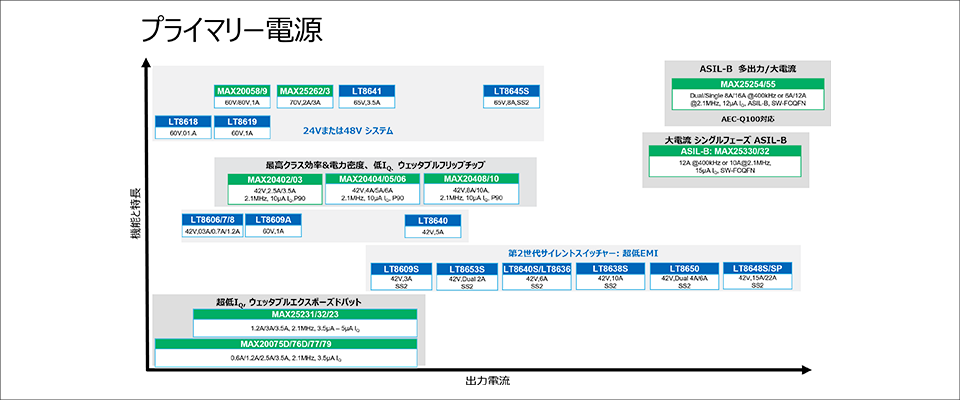
In-vehicle power supplies often have a secondary power supply that converts the power received from the primary power supply and outputs it.
Below is a roadmap for solutions for secondary power.
This also supports various voltages and currents, so you can select the optimal solution according to the specifications of the supply destination such as cameras and microcomputers.
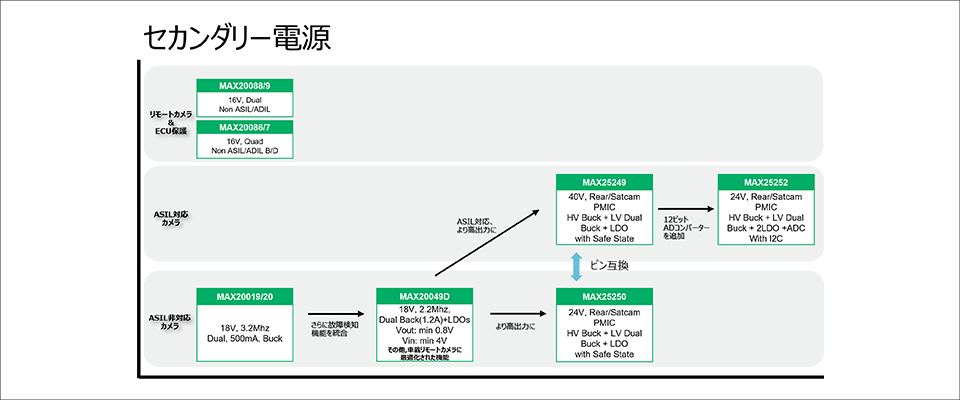
ADI's automotive power solutions are characterized by their high efficiency and ability to contribute to solving issues such as miniaturization and noise reduction. Please use all means.
Power supply ICs are introduced in detail in this article. Please take a look at it.
Power Over Coax that can supply power with one cable
One technology that contributes to the miniaturization of in-vehicle cameras is Power Over Coax, which superimposes power on the signal cable and enables power supply with a single cable.
Analog Devices provides Power Over Coax solutions for camera modules and ECUs.
The figure below is an example of a usage image of Power Over Coax.
In this example, placed on the board of the camera module is a step-down DC/DC converter "MAX20019" consisting of two small chips of only 3 mm x 2 mm.
Power Over Coax dramatically simplifies the power supply circuit, which tends to be complicated.
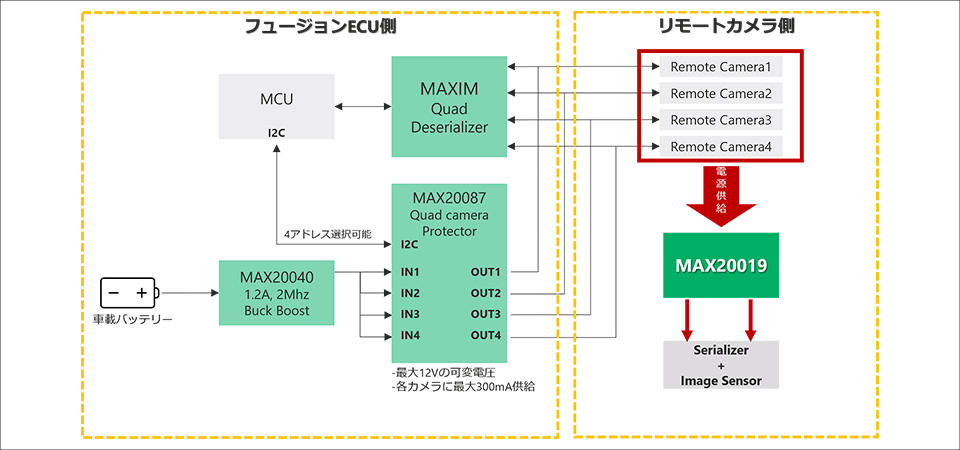
With ADAS, higher image quality and more channels are progressing, and the current required by the camera is increasing. Therefore, solutions that support buck-boost and multiple channels are available for the ECU that is the transmission side of Power Over Coax.
ADI's Power Over Coax solution eliminates the need to squeeze complex power circuits into narrow camera boards, making it easier to achieve smaller cameras, fewer components, and lighter cables.
Products for Power Over Coax are introduced in detail in this article. Please take a look at it.
In this article, we introduced three types of solutions offered by Analog Devices for automotive cameras.
Analog Devices solutions facilitate speedy resolution of technical challenges. If you are interested, please feel free to contact us.
Application example
- ADAS (Advanced Driver Assistance System)
- In-vehicle camera module


Click here for manufacturer site/other related links
- Gigabit Multimedia Serial Link (GMSL) SerDes IC to Advance Safety and Infotainment in Future Vehicles
- Achieved noise countermeasures and miniaturization of in-vehicle power supply circuits. Analog Devices (Maxim) Power ICs for Improved Reliability
- What is a secondary power supply that solves the size and noise design issues associated with the increase in the power of in-vehicle ECUs?
- Clears CISPR25 Class5 requirements! Switching regulator that facilitates noise design for automotive ECUs
- Ideal Diode Solution to Enhance Automotive ECU Safety and Solve Heat and Space Issues
- Resolving issues of miniaturization and noise reduction for in-vehicle PoC! Analog Devices Automotive Camera Power Supplies
Inquiry
If you have any questions regarding this article, please contact us below.
Analog Devices Manufacturer Information Top
If you want to return to Analog Devices Manufacturer Information Top, please click the button below.
